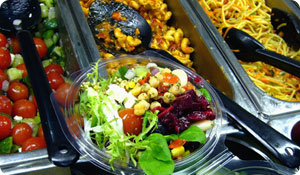
Salad bars present an interesting challenge. They provide a cornucopia of the most healthful foods, but they're also chockful of dietary pitfalls. Load up on cheese, bacon bits, croutons, and creamy salad dressing, and your salad will become as calorie-drenched and fatty as a burger and fries.
Also, studies from the University of Chicago suggest that we do eat with our eyes, and since many salad bars are set up buffet-style, the likelihood of overindulging is high. But if you adhere to the following tips, you can construct a salad that's both nutritious and delicious:
Fill up on the filling stuff. Actually, many items available at a salad bar fit this bill. Fruits and vegetables contain a lower energy density than other foods, meaning that you can eat larger portions while consuming fewer calories. Beans are also a good pick since their high fiber content will leave you feeling satisfied. And don't forget to add a hard-boiled egg: According to recent research published in the International Journal of Obesity, eggs can help people stick to a lower-calorie diet because they impart a feeling of increased satiety and energy.
Get colorful. By loading up your plate with a rainbow of vegetables, you'll ensure that your salad gets a full dose of nutrients. Each plant pigment corresponds to particular health benefits. Red indicates lycopene, potentially beneficial to the heart; orange and yellow suggests carotenoids, which promote the health of the eyes and immune system; blue and purple represent anthocyanins, which are powerful antioxidants; white signals the presence of anthoxanthins, which contain the heart-healthy chemical allicin; and some members of the green group carry lutein, which are good for the eyes, skin, and cardiovascular system, while others are a good source of folate, which promotes and maintains cell growth.
Know your visual cues. If you're aware of what constitutes a proper serving, then you're less likely to get carried away with how much you pile on your plate. So remember that a cup is equivalent to the size of a tennis ball, an ounce of cheese is about as large as your thumb, three ounces of meat, fish, or poultry is no bigger than a deck of playing cards, two tablespoons of salad dressing fills up a Ping-Pong ball, and a handful of nuts is equal to an ounce.
Don't drown your food. A two-tablespoon serving of salad dressing can contain as much as 180 calories and 19 grams of fat. But if you're using a four-ounce ladle filled to the brim with a creamy dressing like blue cheese, ranch, or Caesar, you're smothering your salad with eight tablespoons-which can equal 720 calories and 76 grams of fat. Especially with dressings, keep visual cues in mind, and stick to lower-calorie and lower-fat vinaigrettes.
Replace croutons with nuts. Do you like your salad to pack a bit of crunch? Well, for the same amount of calories, you can enjoy more health benefits if you ditch the croutons for nuts. Walnuts are full of omega-3s, and almonds provide a generous serving of vitamin E, which may help prevent Alzheimer's disease, according to a study published in the Journal of the American Medical Association. Sunflower seeds are also a good source of vitamin E, as well as magnesium and selenium, which promote heart health and prevent cancer, respectively.





